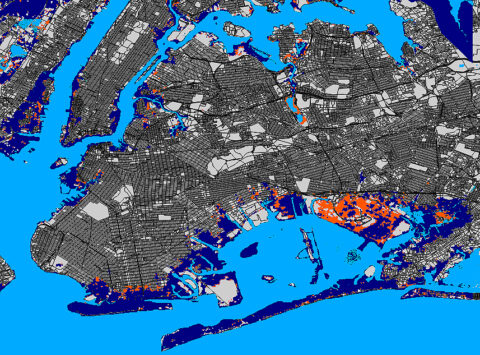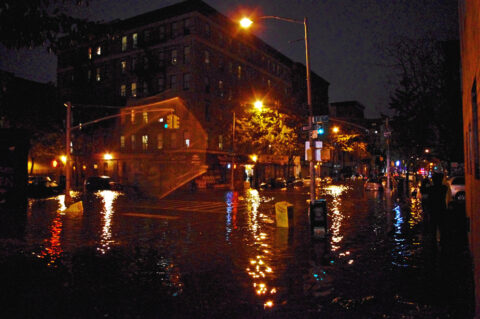To those who think that climate change is an abstract concept, one that might possibly affect their grandchildren in the far-off future, scientists at Climate Central have a ready response. They have calculated that sea level rise over the 20th century caused more than $2 billion in additional damage during Hurricane Sandy in New York City alone.
That additional damage can be attributed to largely human-induced climate change that has already occurred, says Scott Kulp of Climate Central.
“We cannot say that Sandy itself was a result of climate change,” Kulp told Eos, but “we can attribute at least part of the flooding damage from Hurricane Sandy to climate change. It’s a warning for the next decades to come.”
Making “Floodprints”
Sandy hit the U.S. East Coast on 29 October 2012, with a storm surge measuring 2.8 meters, causing extensive flooding in Manhattan and the four outer boroughs of New York City. The last 20 centimeters of that surge would not have existed were it not for sea level rise since 1900, according to Kulp and his colleagues in the United States and the Netherlands.
According to Ben Strauss, also of Climate Central, the group became interested in studying how climate change affected Sandy’s impact after Strauss attended a presentation by Philip Orton of the Stevens Institute of Technology in Hoboken, N. J. Orton discussed modeling Sandy’s “floodprint,” a map showing the areas inundated by the storm surge.
“I proposed that we collaborate and that we basically simulate the same flood, but using a starting sea level 20 centimeters lower, to remove climate-driven sea level rise over the last century.” How would that change the floodprint?
“I proposed that we collaborate,” said Strauss “and that we basically simulate the same flood, but using a starting sea level 20 centimeters lower, to remove climate-driven sea level rise over the last century.” How would that change the floodprint?
Using modeling programs developed by the University of North Carolina, the scientists simulated the observed flooding of Sandy as it hit New York City and also what would have occurred in the absence of the 20-centimeter sea level rise. They applied wind and atmospheric pressure data from Sandy and elevation maps of the city, along with information from the city’s Office of Emergency Management, which identified 33 different types of buildings in flooded areas and their locations within each census block.

Flooding from Sandy actually affected 579,529 people in 250,569 housing units, totaling $11.9 billion in damage, according to the simulation. In the absence of 20th century sea level rise, those figures would have been 520,115 people, 224,540 housing units, and $9.6 billion in damage, said Kulp.
In other words, he said, “The last 7% of the storm surge affected 11.4% more people and 11.6% more housing units than it would have without sea level rise, as well as 24% of the total New York City property damage due to Hurricane Sandy.”
The estimates of economic damages were calculated by Hans de Moel of the Institute for Environmental Studies at VU University Amsterdam in the Netherlands. “What’s interesting,” Strauss told Eos, “is that the contrast in economic damages is greater than the contrast in simple exposure, because the simple exposure represents only the difference in area covered by flood water, whereas the economic damages also reflect the greater depth of water throughout the entire flooded area. Greater depth translates to greater damage, nonlinearly.”

Connecting Climate Scientists with the Public
Climate Central is a nonprofit climate research organization based in Princeton, N. J. Kulp said that it tries to bridge what he called “the huge disconnect” between what scientists know about climate change and what “a very large percentage of the United States population” understands or considers to be a pressing problem. One way to do this is to take events like Sandy and project what would have happened had known consequences of climate change not amplified effects.
The organization is staffed both by scientists studying the near-term impact of climate change and by journalists who translate those findings for the general public. It is funded by grants from major foundations, Kulp said, including Kresge and Rockefeller.
The results of the Hurricane Sandy study were first presented at the American Geophysical Union’s (AGU) 2014 Fall Meeting. The researchers stress that their percentage conclusions are tentative and are being refined with new computer runs, prior to submission to peer review in the coming months. Strauss told Eos that he does not expect the final results to differ significantly from those presented at AGU.
—Harvey Leifert, Freelance Writer; email: [email protected]
Citation: Leifert, H. (2015), Sea level rise added $2 billion to Sandy’s toll in New York City, Eos, 96, doi:10.1029/2015EO026349. Published on 16 March 2015.
Text © 2015. The authors. CC BY-NC 3.0
Except where otherwise noted, images are subject to copyright. Any reuse without express permission from the copyright owner is prohibited.

